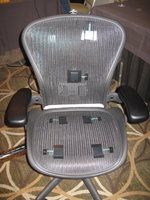Vibrating Chair Fixes Bad Posture
And aims to help prevent lower back pain for cubicle-bound workers
The chair uses seven force-sensitive-resistors (FSRs) placed on the seat and back to sense your body position, plus a distance sensor at the top of the chair back to detect how far you’re leaning away from it.
If the sensor system notices that you are starting to lean forward and hunch over, it triggers one or several of six feedback “tactors,” which are tiny motors like the ones in your cell phone, to start vibrating. The sensors and vibrators together cost just $70.
I tried out the chair yesterday at the IEEE Haptics Symposium in Waltham, Mass. All it took was a short calibration of my sitting upright, slouching, and relaxing poses, then we were off.
Sure enough, as I started to lean forward and hunch, zing! The vibrators under my thighs went off. As I straightened up again, they stopped. I noticed that I don’t sit all the way back in the chair, which is a no-no and prompts more vibrating, so I had to adjust a few times to make sure I was taking full advantage of the chair’s ergonomic potential.
Other positions that are no-go’s: leaning to one side with your arm on the chair’s arm, sitting with an ankle crossed over your knee, and crossing your legs entirely.
The chair’s vibrations are intuitive enough to not need a lot of training, and most of the people who tried it out yesterday caught on right away. Continuous vibrations from the back of the chair mean sit up straight, while vibrations under the thighs mean put those feet down. Pulsed vibration in the chair back means “lean back more,” facilitating guided posture changes.
(Note: this is not a massage chair! The goal is to stop vibrations by moving to the correct position - not to keep the chair going. Oh well.)
But all this sitting up straight can be just as tiring as slouching after awhile. The chair is ready for that, too. Ying (Jean) Zheng, a graduate student who leads this research in John Morrell’s human-machine interface lab at Yale, explained that the system can be programmed to let you sit back in a (proper) relaxed posture every 20 minutes or so.
While most subjects have used it for testing only, Zheng says she uses it for hours at work, and that it helps her posture (she did appear to be sitting up straight even without a vibrating chair of her own during the long day of demos).
According to the group’s paper, subjects studied do tend to sit up straight even after the vibrating stimulators are turned off. So it could work well for training and rehabilitation, too.
Photos: (Top) Force sensors placed under the “sit” bones and thighs, and behind the lumbar region of the spine and shoulder blades. The seventh force sensor is placed in the center rear of the seat to make sure you’re sitting all the way back in the chair.
(Bottom) Conference participant trying out the chair.
